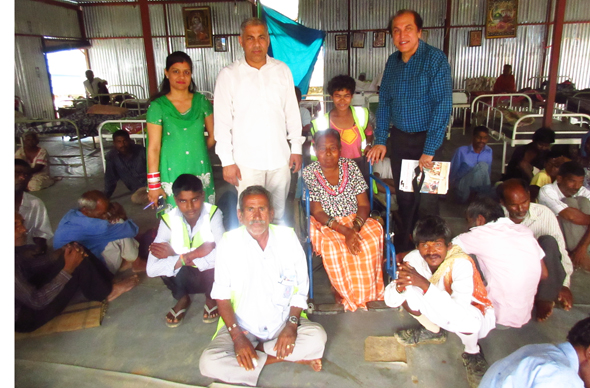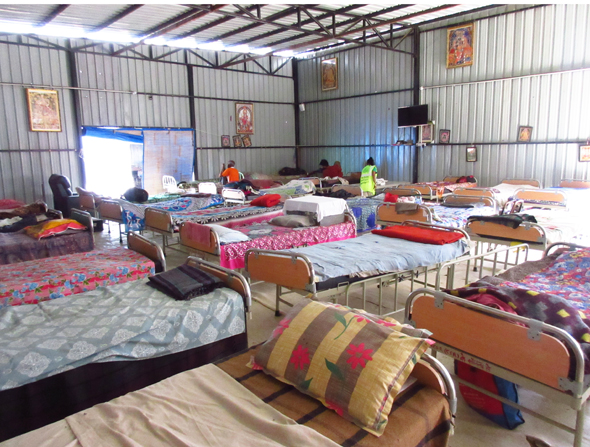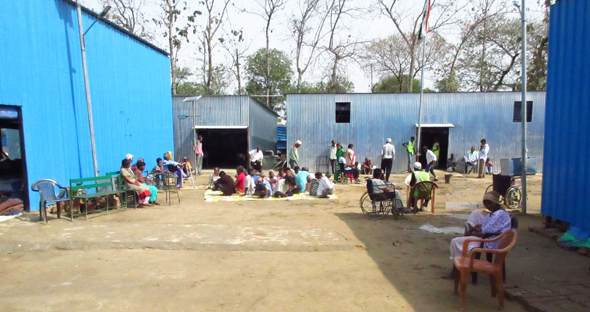Discarded People Find a Welcoming Home Tucked Away, Out of Sight

At the Earth Saviours Foundation shelter outside New Delhi, standing among residents, from left, Rakhi Sharma, Administrative Manager; founder Ravi Kalra, and IAN Publisher Jawahar Malhotra.
Photos: Jawahar Malhotra
By Jawahar Malhotra
NEW DELHI: In this megacity of over 20 million people, for the forlorn and clueless; those who have been discarded by society as unstable, mentally ill, unfit and unwanted, even after they are dead and the bodies lie unclaimed; for those whose families have deemed them to be more of a bother and inconvenience; for the women who have gone crazy after being molested and raped; for the refuse of society that Delhiites reject and do not treat well, there are very few places where to find refuge and to live out their years in dignity.
The NCR – National Capital Region – runs through three states, from Ghaziabad in Uttar Pradesh to Bhiwadi in Haryana Pradesh and Rohtak and Najafgar in Haryana to the west, a vast area that accounts for an estimated 55 million densely packed people. Although in New Delhi there are clean bureaucratic government buildings and housing; tall apartment buildings; new four-story townhomes where bungalows once stood; gleaming opulent malls and an elevated Metro system that is the envy of the nation; outside in the heat, on the filthy streets and traffic congested roads lies a mess of humanity trying to eke out a meager living in a thousand different ways. Some are clueless on how to fend for themselves.
This city is teeming with government run hospitals and private clinics all too ill-prepared to handle the avalanche of people affected by life’s vagrancies; and the few mental health centers are private and charge enormous amounts of money that the destitute and those unable cannot afford. But in all of the NCR’s megapolis, there is only one place where even the police bring in the rejected they find; a place that turns no one away and charges no money but offers hope and a caring heart.
Going southwest on the National Highway 8 to Jaipur, due west of the Indira Gandhi International Airport and almost behind the 80-foot-tall statue of Shiva and the Shiv Murti mandir that sits at its feet is the Earth Saviours Foundation, about a quarter mile away along jutted and negligible roads, through a pop-up village of mostly Bangladeshi refugees and mounds of trash on the horizon.
The Gurukul or safe haven sits on 2.5 acres of land leased out free by a kindred benefactor after shifting there when a disastrous fire in April last year destroyed the previous shelter that was closer to the city. According to Ravi Kalra, the founder of ESF, there are plans to buy 3.5 acres of land on the Mehalpur-Faridabad road with hopes to build “the world’s biggest charitable temple of humanity” that could accommodate 600 to 800 people. The present site can handle a maximum of 250 residents and has a staff of 35, mostly volunteers who came as patients years ago and stayed on to serve, two paid staffers who handle paperwork and a paid cook.
Kalra recalls being horrified to see a young child eat from the same city garbage heap as a mongrel dog. In response, he opened up the first shelter in 2007, feeling that serving the destitute was his true calling in life. He gave up his comfortable lifestyle, business and eventually his wife and children to devote himself to this cause full time. “I have vowed to help the destitute and unwanted; have cleaned their vomit, changed their diapers, helped to rid them of maggots on them,” described Kalra of his daily routine on a recent visit through Houston last year (see IAN dated Sept. 26, 2014) on a fundraising drive to three US cities. He even performs the last rites for those who are brought dead from the streets, some decapitated and dismembered; others who die while in his care.
As I toured the shelter with Kalra, I met with some residents who came to give him an affectionate hug, touch or kind word while they warmed themselves in the April sun. An Indian-origin woman from South Africa with her baby had taken refuge for a few months; another middle-aged African woman had taken haven for a year. But most of those who arrived each day were the penniless and witless, picked off the streets and brought by one of the four make-shift ambulances that were donated to the shelter. And there were many women who had been raped, lost their minds and were weeping, or locked into their cocoons and a few screaming at anyone who walked by; like the woman who shouted angry obscenities about her man’s betrayals.
Others included a brilliant Bengali man who ran a small, part-time asset management business but Parkinson’s disease, not revealing what made him seek shelter here; an octogenarian in a worn-out suit and a shock of white hair suffering from the onset of Alzheimer’s was being processed in as his family could not take care of him and had dropped him off and an elderly judge from a rich family likewise brought her by his relatives to spend his final days here.
Kalra, 46, spends most of his days in the midst of this maelstrom, having spent his savings to start and run the shelter on a shoestring budget, depending on the charity of those who have come to learn about it and the benefactors who drop in over the week to see what they can do, bringing old clothes, food and donating money. “Most Indian corporations do not support us; it’s all through word of mouth,” explained Kalra of the Rs. 1,000,000 to 14,000,000 (about $22,000) a month that it takes to run the shelter. He was able to raise some contributions during his US trip, but many pledges lie unfulfilled.
The ESF has been publicized in the media but is still relatively unknown. A family which had just lost their breadwinner father and husband came to donate a day’s meals. A small band of students came to help the residents who sleep on donated beds and live in three steel-framed buildings, with open restrooms and bathing areas in the courtyard. Occasionally, a foreign European or American will spend a few weeks helping with the care.
Through this all, Kalra remains undaunted; saying he could not turn his back on the helpless and ruined people who have become his life’s work and for whom, he has become a lifeline.


